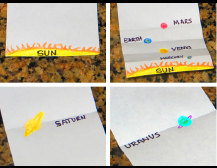Our Solar System contains the Sun, 8 planets, and many small objects like dwarf planets, moons, and asteroids.
Each planet travels around the Sun on a large, curved path called an orbit. The planet with the closest orbit is Mercury. After Mercury comes Venus, Earth, Mars, Jupiter, Saturn, Uranus, and finally Neptune. Most of the asteroids are found in the area of space between the orbits of Mars and Jupiter, called the asteroid belt.
Many of the images you see online don't show the vast scale of the Solar System! Complete this activity to find out how far apart each planet really is.
By the end of this activity you will:
- Be familiar with the order of the 8 planets in our Solar System
- Have created a scale model of our Solar System
- Appreciate the relative sizes of the distances between each planet’s orbit
To complete this activity you will need:
- A3 paper cut into long, thin strips (you could also use a length of till-roll paper or toilet paper)
- Pens or pencils

Have a go
Before you start, make you have all the items you need.
Step 1: Prepare your equipment
You will need a length of till-roll around 30-45cm long.
- Take two long strips of paper, you may need to create these by sticking strips of A4 or A3 paper together.
- On BOTH pieces of paper, write Sun very close to the top and Dwarf Planets very close to the bottom.
Step 2: Estimate the distance between each planet and the Sun
- Think about where you think each planet falls between the middle of the Solar System (where the Sun is) and the edge of the Solar System (where most of the dwarf planets are).
- On ONE of the strips of paper, mark where you think each of the 8 planets should be and label each mark, so you know which is which.
Step 3: Discover the true answer
Take your second strip of paper and follow these instructions:
- Fold the paper in half and write Uranus on the crease.
- Re-fold the paper and then fold it in half again. Write Saturn on the crease ¼ down the page, and write Neptune on the crease ¾ down the page.
- Fold the paper from the Sun to Saturn and write Jupiter at this crease, which should be 1/8 down the page.
- Next, fold from the Sun to Jupiter and write Asteroid Belt at this crease, 1/16 down the page.
- Then, fold from the Sun to the asteroid belt and write Mars at this crease, 1/32 down the page.
- Finally, write the remaining planets (Mercury, Venus, Earth) evenly in the space between the Sun and Mars, in that order with Mercury closest to the Sun.
How does the true scale compare with your estimate? Was your guess close?
If you want to check what the true scale should look like, use this answer sheet.
